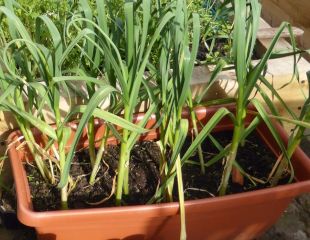

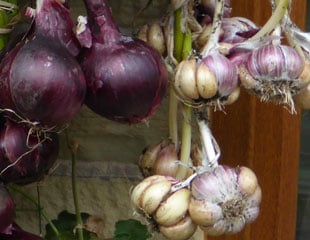
How to Grow Garlic
You can plant Garlic in autumn or spring, but Garlic grows best when planted in the autumn. This is because autumn planted garlic has the benefit of 1-2 months of cold temperatures, 0-10C, which helps the bulb formation producing a better yield.
If you are growing garlic in soil which is wet over winter, autumn planting may not be ideal. Garlic bulbs may rot in cold wet soil. Either plant in containers or wait until the spring.
Commercially, a large amount of Garlic is grown in the Isle of Wight, and it is no coincidence that this is one of the sunniest places in the UK and it has very free draining soil. It follows you need to plant garlic in the sunniest spot in your garden.
Garlic is one of the easiest veg to grow, as are onions and shallots, and all suitable for growing in containers. Once harvested, Garlic will keep for months in suitable conditions so you can enjoy home-grown garlic all the year round.
How Hardy Is Garlic
Hardiness ,as you may expect, depends on the variety of garlic. Varieties referred to as Hardneck are the hardiest tolerant well below 0 degrees but it stores less well. Softneck garlic is less hardy but it will store well all over winter. The least hardy is Elephant garlic.
In part, it also depends where you are in the country. I have grown garlic in the North and Midlands and have not covered autumn planted garlic with any frost protection. Garlic is hardy in terms of an average English winter and only if very severe weather and snow conditions are forecast, would it be prudent to cover it. Remember that snow is heavy and fleece protection may weigh down on the plants and cause damage, a cloche may be more effective.
Should you plant supermarket garlic bulbs?
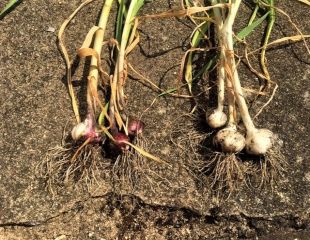
Garden wisdom recommends growing Garlic from certified bulbs, purchased online or at the garden centre, not from saved bulbs. This ensures the plants are disease free, and that is correct. Sellers market specific garlic varieties for either autumn or spring planting. If you are buying from a garden centre/on line you may find the RHS fruit and veg plant trial list helpful.
But with an eye to increasing costs of gardening, to keep costs down, last year I planted some certified bulbs and some supermarket bulbs. The image left shows the result. The white bulbs are an unspecified supermarket bulb and the red purchased from a garden centre.
Very similar results, if anything the supermarket is better. Next growing season, I will look for a large organic bulb to plant from a vegetable retailer/farm shop. The one thing you need to be aware of is that garlic sold by food retailers is almost always soft neck, but even so, it should easily withstand an English winter. Softneck tends to be milder in flavour and keeps well.
What is the best garlic to grow ? What about Wild Garlic
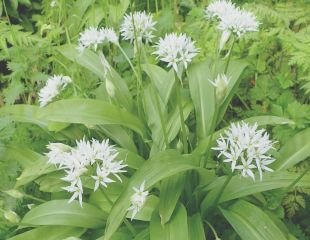
Wild garlic grows in completely different conditions than standard garlic. It's a completely different sort of plant, grown for leaves and not bulbs and loves a damp shady area.
If you have no space for conventional garlic, why not try growing wild garlic?
More information and growing tips:
How to plant Autumn Garlic
I prefer to plant Garlic in the autumn for better bulbs and earlier harvest. If your plot is reasonably well drained, Garlic can be planted any time during autumn and early winter through to November or December. Plant Garlic in full sun and to a depth that the tip of the bulb is about 2.5 cms (1")below the soil surface. This is in contrast with onions, which are planted so that the tip is just poking out a little above ground level. Soil preparation is easy, good soil, with added organic matter and not compacted, and free draining.
If you plant garlic in containers for growing on in the spring, it's best one per pot or just 2/3 into a container. If too many cloves are planted into one large pot, it's hard to extract the garlic in the spring as the roots merge and are difficult to separate.
Why does Garlic need a cold spell
An additional reason to plant Garlic in Autumn is to get better bulb formation.
Garden wisdom recommends that garlic has a period of cold weather which is why Autumn planting is ideal. The question is why? The technical term is vernalisation. This cold period, a month below 10C and/or ideally 1/2 weeks at below freezing, activates the gene in the garlic bulb which makes the single bulb form more individual bulbs. The cold spell really does promote better bulb formation. Without any cold spell ( which in the UK would be unlikely in either Spring or Autumn planting) just one single bulb would form and grow, more like an onion than garlic.
This also accounts for the fact that the best place to store garlic pre planting is in the fridge.
How to Plant Spring Garlic
Garlic should always be in full sun (it is a Mediterranean plant) with rich soil which is free draining. Garlic does less well on acidic soils and if your Ph is high, you may need a little lime, or in containers with a neutral compost.
When planting garlic, take the whole garlic and break it open as you would select a bulb for cooking. Separate out each individual bulb and plant each bulb flat end down and pointy tip upright the same as it was within the garlic bulb. Some growers recommend separating out the bulb first and leaving for 24 hours before planting out. Plant garlic in rows about 10 cms apart and about 5cms deep so that there is around 2.5 cms of soil covering the bulb.
Within a matter of week/two depending on the weather, the shoots will start appearing. As with everything grown in the veg plot, you will encourage larger bulbs by incorporating organic matter into the soil before you plant, and feed along with the rest of the plot once planted.
Garlic is suitable to grow in containers. The golden rule with all container grown veg is that the planting environment needs more attention, as it will be prone to drying out and extra feeding. Unless fed and watered well, garlic grown in containers may produce smaller bulbs. Check out which other vegetables are suitable for growing in containers.
When is Garlic ready to Harvest?
Harvest Garlic late in the summer to give it a long growing season. Softneck garlic will collapse when it is ready to harvest, which means the stem will lie prostrate onto the soil. With hardneck garlic, which produces flowering spikes, the outer foliage will turn brown when it is ready to harvest.
How to Store Garlic
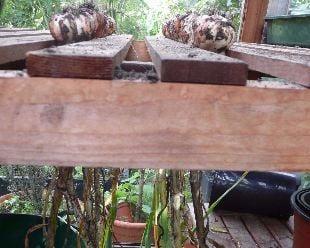
Garlic, once lifted, must be dried somewhere warm and be completely dry before storing, which is really important. If the bulbs are not completely dry, there is a risk dampness will rot the bulbs and others stored around it. Like onions harvested on a dry day and leave on the warm soil to dry.
Given our summers, this traditional ways of harvesting can be difficult to accommodate. Alternatively, if you have a greenhouse, dry upside down on the slats, (see image left) or place in netting in a shed, or lie on newspaper on a sunny windowsill or conservatory. When the garlic has throughly dried, knock off any remaining soil and store somewhere cool and light, again in a conservatory, garage or porch.

The dried top growth can be platted to make an onion/garlic string. If the top growth is not as robust as would be ideal for platting, you can weave in some raffia to supplement it.
Although Garlic plaits look nice in the kitchen, it's not the ideal storage place, (being too warm and humid) it's best to just bring in a few bulbs at a time and store the rest of the garlic elsewhere in the cool.

Garlic is easy to grow and tolerant of most soil conditions - definitely a green wheelbarrow plant
